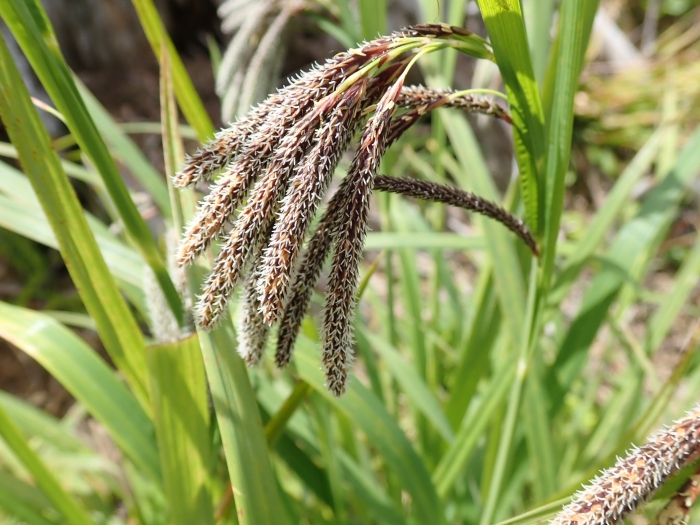Mertens’ Sedge
(Carex mertensii)
Mertens’ Sedge (Carex mertensii)
/
/

John Brew
CC BY 4.0
Image By:
John Brew
Recorded By:
Copyright:
CC BY 4.0
Copyright Notice:
Photo by: John Brew | License Type: CC BY 4.0 | License URL: http://creativecommons.org/licenses/by/4.0/ | Rights Holder: John Brew | Publisher: iNaturalist | Date Created: 2019-06-04T17:52:53Z |
























Estimated Native Range
Summary
Carex mertensii, commonly known as Mertens’ sedge, is a perennial herbaceous plant native to the moist and wet subalpine and alpine forests, meadows, and streambanks of western North America, ranging from Alaska through California to Montana. It typically forms dense clumps of stems that can reach heights of 31 to 47 inches. The foliage consists of narrow, grass-like leaves that contribute to its tufted appearance. Mertens’ sedge is particularly noted for its distinctive inflorescences, which are bullet-shaped and hang on long peduncles. Each inflorescence measures about 1 to 2 inches long and is accompanied by dark-colored bracts that enhance the plant’s visual interest.
In cultivation, Mertens’ sedge is valued for its ability to thrive in moist conditions, making it suitable for rain gardens, wetland plantings, and as a naturalizing element in water features. It prefers cool, moist environments and can tolerate a range of soil types, provided they are well-draining. This sedge is relatively low-maintenance, requiring minimal care once established, and is often used in restoration projects due to its ecological benefits, such as erosion control and providing habitat for wildlife. It is not known for significant problems with diseases or pests, but it can be sensitive to drought conditions.CC BY-SA 4.0
In cultivation, Mertens’ sedge is valued for its ability to thrive in moist conditions, making it suitable for rain gardens, wetland plantings, and as a naturalizing element in water features. It prefers cool, moist environments and can tolerate a range of soil types, provided they are well-draining. This sedge is relatively low-maintenance, requiring minimal care once established, and is often used in restoration projects due to its ecological benefits, such as erosion control and providing habitat for wildlife. It is not known for significant problems with diseases or pests, but it can be sensitive to drought conditions.CC BY-SA 4.0
Plant Description
- Plant Type: Grass
- Height: 1-4 feet
- Width: 1-2 feet
- Growth Rate: Slow
- Flower Color: N/A
- Flowering Season: Spring, Summer
- Leaf Retention: Evergreen
Growth Requirements
- Sun: Full Sun, Part Shade
- Water: Medium
- Drainage: Fast, Medium
Common Uses
Erosion Control, Low Maintenance, Water Garden
Natural Habitat
Moist and wet subalpine and alpine forests, meadows, and streambanks
Other Names
Common Names: Purple Sedge, Bristle-stalked Sedge
Scientific Names: , Carex mertensii, Carex columbiana, Carex mertensii subsp. mertensii,
GBIF Accepted Name: